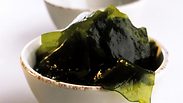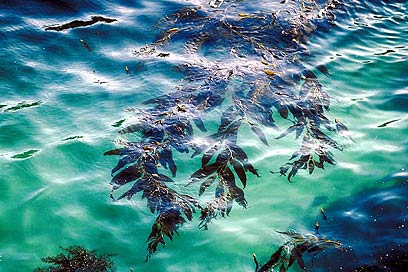
Israeli scientists explore algae as biofuel producer
New research shows that growing and producing bioethanol from algae of the species sea lettuce has potential but is not currently viable economically.
New Israeli research has shown that growing and producing bioethanol from algae of the species sea lettuce has great potential. However, the study has found that it is currently not economically viable.
The global energy industry is constantly looking for renewable and environmentally friendly energy sources. Among the proposed solutions, fuel production from plant material has been marked as having a high potential. Plants are "primary producers", that is, they are able to harness the sun's energy and amass carbon dioxide to produce sugars and fats that make up tissues. Plant material can produce biodiesel or bio-ethanol, which can be used as a substitute for fossil fuels.
In the last few decades there has been a rapid development in the pace of fuel manufacturing from plants, and at the beginning of the decade production was close to two million barrels per day. On the other hand, extensive growing areas needed for growing the plants come at the expense of producing food crops and also the economic profitability of the growth process and gas production is often marginal or such that it relies heavily on government subsidies.
New research at Tel Aviv University, which has just recently been completed, wanted to check if innovative methods of producing energy from algae are not only technically feasible but also economically sensible.
Energy, food and detoxification
The advantages of growing algae as a plant alternative to produce energy include a fast growth rate, a simple production process and the utilization of habitats not used for food agriculture. Already in the 1950s the United States invested in research to improve the growth of algae to produce energy, but later it lost popularity following the changes in the energy market and limited success in growing algea.
However, in recent years, algae growth for energy is making a comeback due to growing awareness of the environmental implications of fossil fuel use and the fear of future instability of fuel sources currently used. At the same time technological innovations that allow the development of species of algae richer in fats and sugars, as well as methods for their production, may make the dream economically worthwhile.
Despite algae's potential, it seems that the price of biofuels is currently too expensive to compete with fossil fuels, due to manufacture and production costs. For example, the cost of production of biodiesel from algae is currently estimated at seven dollars per gallon, double the price of regular gasoline.
Therefore, it is necessary to find additional applications to accompany the algae-growing process and plant material produced and to make growth profitable. For example, an increase in marine algae, which contain organic material may help to clean seawater where the marine environment is polluted as a result of enrichment with organic matter. An example is the marine environment in the vicinity of fish farms, where large quantities of food and fish secretions flow into the sea, leading to its pollution. Another possible source of income is the utilization of remaining plant material after ethanol production in the food industry for livestock and fish in particular.
Coming full circle
Research at the National Institute of Oceanography in collaboration with Tel Aviv University and Bar Ilan University examined different stages in growing and producing bioethanol from algae of the species sea lettuce (Ulva). The study was led by Lior Korzen as part of his doctoral work. Among his academic advisors were experts in various scientific fields: Prof. Avigdor Abelson of Tel Aviv University who specializes in marine ecology, and Prof. Israel Alvaro of the National Institute of Oceanography who specializes in algae.
Korzen bred algae near a sea bream commercial farm located in Mikhmoret on the Mediterrranean coast near Netanya. The algae were connected to net baskets that prevent their being swept away and that allow exposure to light and nutrients from water currents. "The growth focused on the Ulva genus of algae as we saw that it was a more efficient producer of sugar compared to other algae examined, and because you can grow it during most of the year," said Korzen.
During the field work it was discovered that algae that grew downstream from fish cages located in Mikhmoret enjoy water enriched with organic matter and show a faster growth rate of 27 to 40 times compared with algae placed upstream from the commercial fish farm. As mentioned above, the profit of such growth is twofold: on the one hand increased growth rate and on the other hand, water cleaning. "The idea is to provide a solution to a problem that exists and will worsen with time, marine pollution due to acquaculture . Ulva serves successfully as a bio-filter for contaminated water," explained Korzen.
The next challenge lies in producing ethanol. This process involves the breakdown of complex sugars such as starch into simple sugars such as glucose. Then, through the process of fermentation ethanol is produced. Korzen, guided by Professor Aharon Gedanken, developed a method in which the breakdown of complex sugars is done in conjunction with the sonication process, during which the products are often exposed to frequencies. Results showed that this method has an advantage in expediting the breakdown process.
The bottom line
After studying the methods of optimal growth and improvement of the production process, Korzen turned to developing the economic model that examines the profitability of the endeavor . The aim was to examine how the volume of production and market forces affect the profitability of growing Ulva. The model included the cost of the construction and maintenance of the growth system as well as harvest costs and transportation to the production site. To this was added to the price of the production process and manufacturing the end products. The revenues that were taken into account in the model included the compensation to be received for the bio-ethanol produced in the process, and the vegetal sonication which is supposed to help in the production of food.
The model results showed that given the prevailing market conditions and current growth, profitability is achieved only if there is a huge amount produced. Maximum profitability - almost 20 million euros for a period of 15 years of activity - can be achieved when the area of growth reaches 2,500 hectares. By comparison, according to future plans prepared by the Ministry of Agriculture, the area allocated to aquaculture in Israel is about 600 hectares. Therefore, in such a limited area, the model predicts a negative return of around 13 million euros for a similar period.
It seems, therefore, that an increase in trade of seaweed to energy is not worth existing conditions in Israel today. However, a similar economic model may be appropriate for areas where available space larger growth. Former cites the example of the work done in China where marine farms covering an area of one million hectares.











